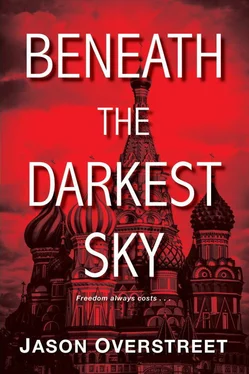I climbed up and pointed my flashlight. What I saw was an oddity in terms of how structures are built. The top of my ladder touched the bottom of a wide, metal one that was mounted to the wooden wall of a shaft that ran all the way to the roof. It was very narrow, just wide enough for a person to fit through. Studying my surroundings, I realized that this portion of the back wall behind me had been recently added to create this shaft, the outside façade appearing the same.
Many of the windows around the house were inlet, allowing such an add-on like this not to disrupt the aesthetic. None of the exterior walls of Spaso was flat from corner to corner, as there were sections that extended out from the main frame similar to the way a fireplace shaft extends out from the exterior.
I climbed the ladder with my rear to the new wall, my face to the original. When I reached the crawl space that separated the first and second floors, the wall discontinued, allowing me to point my flashlight inside the fourteen-inch-high opening. The joist bay directly in front of me ran all the way to the front of the house, which meant they all did. These weren’t your typical joists, either. They were open web wood trusses, the type I’d only seen on bridges back in America. But, of course, Europe and the Soviets were far ahead of us architecturally. The trusses had triangle patterns, like lattice. From a physics standpoint, using them made sense, as they had much more capability for loads, based on span and depth.
I reached inside the bay and picked up a folded piece of paper. I opened it to find an entire floor plan of the crawl space. Each joist bay was numbered and first-floor rooms were labeled. There were measurements and markers that showed exact drilling points. What I was reading told me that the drilling points through the crawl space would allow microphones to be dropped behind the walls of the ambassador’s library and office. There were also access holes to the walls behind the oval dining room, music room, state dining room, and even Bullitt’s brand-new ballroom.
I looked again at the open web trusses. The triangles were large enough for a small person to squeeze through. The dwarf I’d seen could weave his way all along the crawl space. I was sure he’d been tasked to do just that, probably placing microphones above and below various rooms, as the second-story floor was essentially the top of this crawl space. I placed the paper back where it had been and contemplated entering the joist bay. Unfortunately, I was too big to make my way inside.
Pointing my flashlight up, I began to climb again. Visions of the NKVD dwarf and his partner ran through my head. They had me a bit spooked. In fact, Spaso House as a whole did. I’d learned of its history.
Perhaps parts of the mansion had been reconstructed after the revolution. That’s when it began housing the government’s Central Statistical Office. It was then used as the reception house for the Central Executive Committee. The People’s Commissar for Foreign Affairs, Georgy Chicherin, had only stopped living here in 1930. Maybe all of those years since the revolution had brought with them several “secret” house makeovers.
And as for the tunnel that began behind Sergei’s stove, it was probably an original escape route, much older than this corner shaft, which was likely built to spy on the Americans. I was guessing the escape tunnel hadn’t worked for Nikolay Vtorov, the original owner, who was a wealthy merchant and had lived in Spaso House from 1913, when it was built, to 1917, when he mysteriously died during the Bolshevik Revolution.
I continued climbing, finally reaching the attic above the sleeping quarters, the one I’d been in many times before. I crawled inside and sat. Pointing my flashlight around, I realized it wasn’t the same space. The original attic had been partitioned into two horizontal spaces, one for guests like the Americans to enter from the regular inside door, and this one below it that could only be reached from where I’d come. I pointed my flashlight up and could tell the wood used to divide the attic was much newer. No wonder the attics are so shallow .
Still pointing my light, I could see large recorders everywhere. I began crawling but had to stop because of a four-inch-wide crevasse in the floor. Running my flashlight along the opening, it was the exact size of the ambassador’s bedroom, a large, rectangular crevasse. It was the typical space that separated one room’s wall from another, except the ceiling portions had been carved open. I pointed my flashlight straight ahead into the distance and could see similar crevasses outlining other rooms along the attic floor.
Trying to calculate where I was in relation to the ambassador’s office two floors below, I began to crawl in that direction. I looked down into a crevasse that outlined two rooms: a guest room on the second floor, and the ambassador’s office just below on the upper lobby first floor. My knee almost bumped into a mounted fishing pole. Beside it was a large recorder the size of a suitcase. It was turned off.
Shining my light way down into the crevasse, I could see a microphone hanging from a wire that was running from the pole. The lengths they’d gone to! My educated guess told me the microphone was hanging right behind the ambassador’s desk.
I sat on my behind, legs crossed, and took several deep breaths, the low ceiling reminding me once again that just days ago, Sergei had been bitching and moaning at me as I’d crawled around in the attic just above me. The real one!
I loosened my bow tie as sweat dripped from my nose. Part of me was terrified that I’d perhaps put myself in a trapped position. I couldn’t help but wonder if an NKVD spy was coming up the ladder behind me. Still, my desire to see more was driving me, and though both the ambassador and I had imagined such hidden devices, what I was witnessing sent chills up my spine. The extent to which Stalin had gone to embed this mansion with microphones, as if they were no different than mousetraps, was literally beyond comprehension. Spaso House was an infested spy complex. NKVD practically lived in these recently constructed spaces.
I crawled back to the vertical shaft and pointed the flashlight straight down. No one in sight. Are there more secret shafts on the other side of the house ? Will this one disappear when the government decides to “ remodel .” Are there hidden microphones in the garage, housekeeping facility, barn, or washhouse? All I knew was I couldn’t touch or remove a single device from this place. All I could do was return to the apartment, replace the ceiling tiles, return everything to its rightful position, place the keys back on Sergei’s belt, and rejoin Loretta, Bobby, and Dorene. But I couldn’t wait to tell the ambassador what I’d seen.
* * *
My dotting i’s and crossing t’s regarding what I’d seen at the Christmas Eve Party some four months earlier was interrupted when Bobby finally showed up at the office, just in time for us to make our way over to the Kremlin to meet with the Premier. We were stopped by at least ten different security guards on our way inside Corpus Number One, and when we finally arrived at his office on the second floor, he was sitting at a large desk made of thick, dark wood. He was wearing a brown suit.
The guard who was accompanying us motioned for us to remain still while Molotov finished writing something. It gave me a moment to scan the place. The entire office, with its high ceiling, was full of thick chairs and rugs and bookshelves. It had four windows that overlooked the courtyard. All of the walls were covered with dark, polished, wood paneling. It screamed of the old czarist times, as both the size and quality of the office was fit for a king. But in reality, the only king was encased in a frame behind Molotov’s desk, one Joseph Stalin.
Читать дальше











